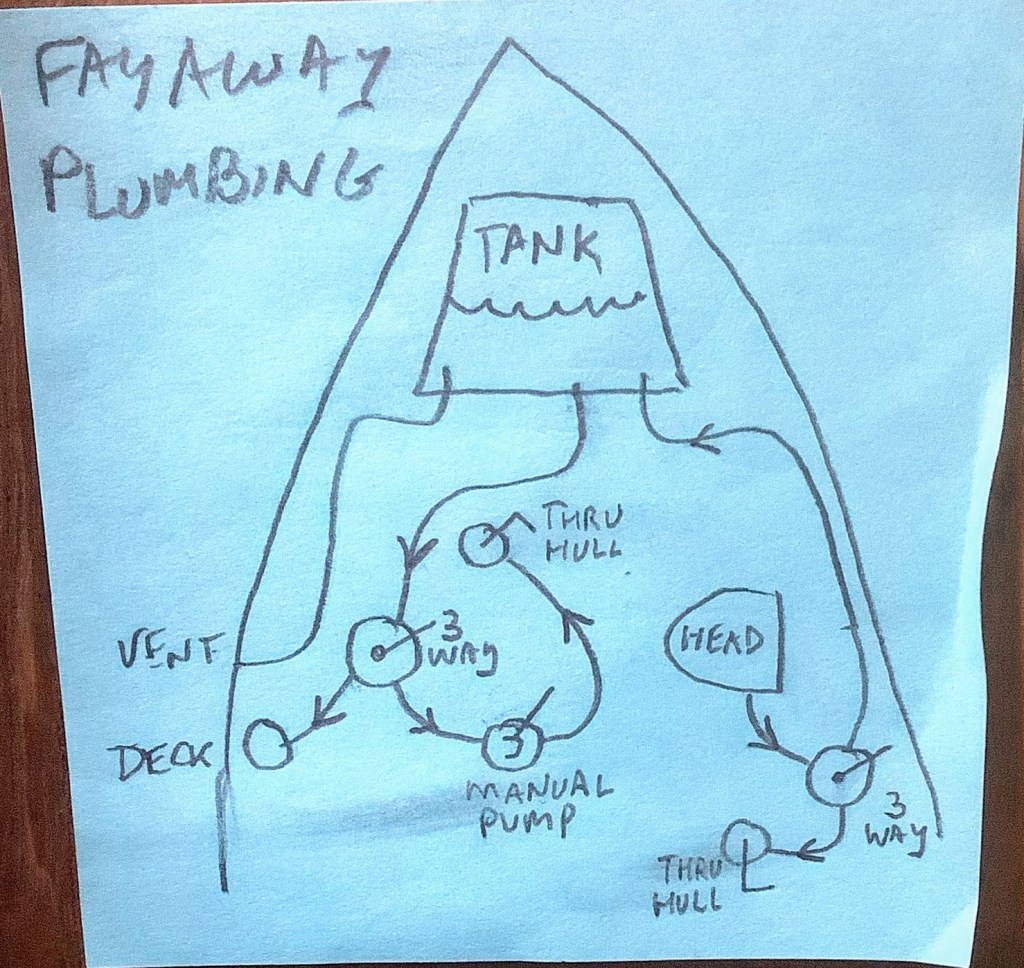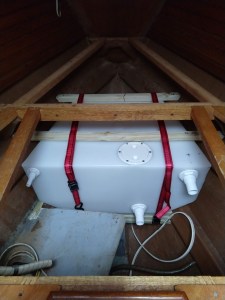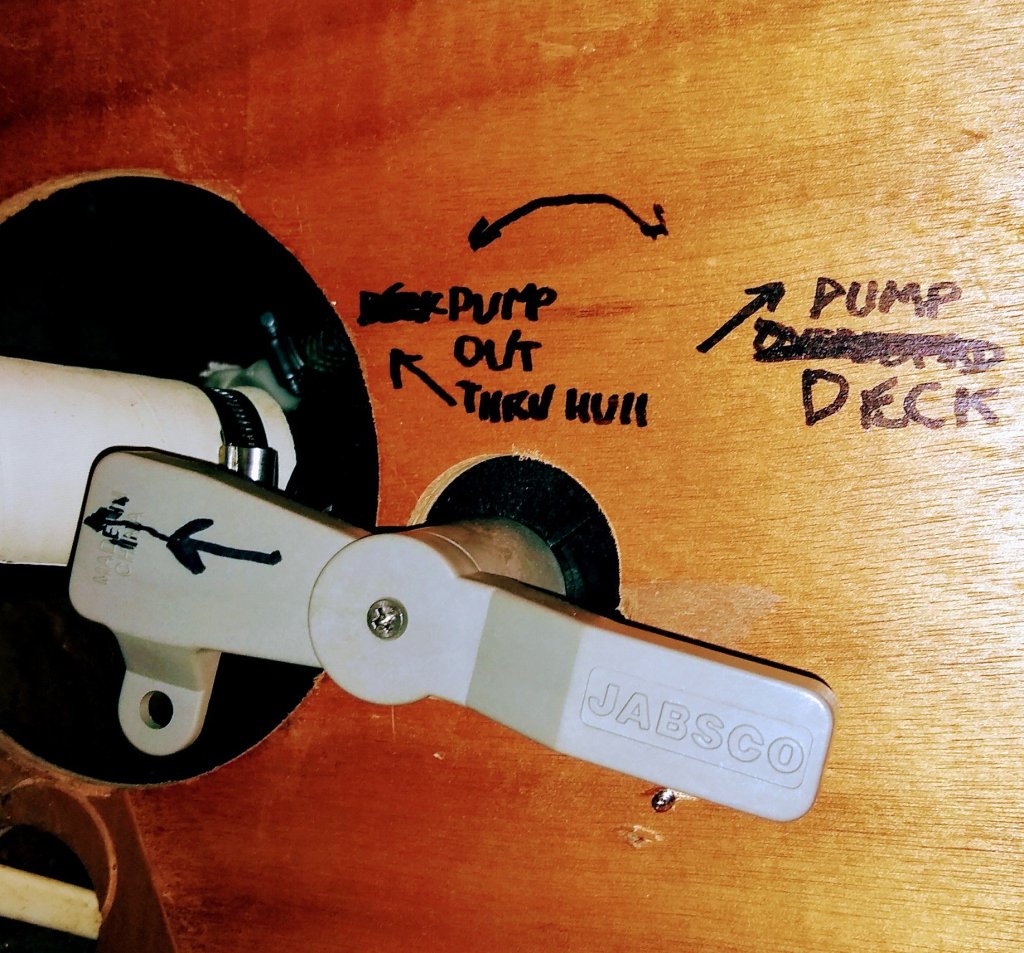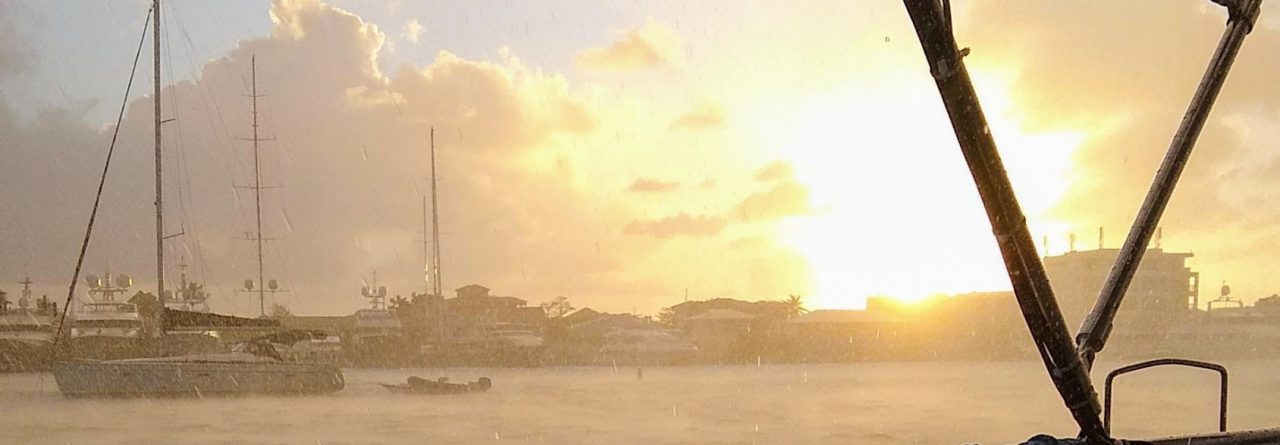Before leaving Newburyport last year we completely replaced everything in Fayaway’s ancient septic system – except the toilet itself. (It was fairly new). You may have read about this fun project in our earlier post: Martha’s Vineyard Doesn’t Stink.

Our fancy new plumbing system works really well. And without too much detail, suffice me to say that we’ve proven it’s functional abilities quite a bit since moving aboard. We try to be responsible with our raw sewage. But after almost eight months there has been something still lingering.
Warning: folks squeamish about bad smells should STOP READING; this will get messy, and possibly offensive!

We began in earnest boat projects way back when, in the cooler days of early April, and still had a protective cover (with snow) over Fayaway. Starting from the bow, and working my way toward the stern, was my order of projects. So, with the holding tank upfront in the bow, it was number two on the list (hee hee! After the windlass). I researched the crap (sorry, just couldn’t help that one) out of how to make our system simple and faultless.


In hindsight, additional concern should have been obvious when we first started out. I hadn’t yet installed a tank level gauge, and figured we’d just empty the 25 gallon tank every few days. It should hold enough for a week, right? I had labeled the three-way valves which control the sewage direction (going into the tank or overboard?), and so figured we were off to a good start. Having studied their construction prior to installing the new 3-way valves myself, I assumed we knew how to use the system correctly (albeit 3 months later, in July) based on my foggy memory of which way the valve handles should be pointed. The gray handle points in the direction of flow… right? Well, the directions don’t say anything about which way should the handle point. We should be ok; I’m pretty sure.

So, off we went cruising up toward the beautiful Maine coast. At this time we anchored often in open harbors and had been switching the “overboard” valve to do just that with the sewage, and thus help keep the tank level low for a longer time. Or leave more tank capacity for when we were in more protected water. (Ok, ok, please don’t lecture me on what the USCG rules say; we already know).

Late one sunny afternoon as yours truly was flushing a bladder-full of “processed” beer, Kelly noticed a dripping sound coming from under the v-berth. She had fortunately been near enough to the tank location under the v-berth. She inquisitively pulled up the cushions and immediately started yelling, $$$hhhiiiit! STOP FLUSHING!”

Oh crap! Literally. Colorful and pungent liquid was squirting and spraying out of the only place it could – the inspection cover, pouring over most of the items lucky-enough to be stored in its vicinity. Obviously the cover seal isn’t strong enough to hold the head pressure (bad pun) of my pumping the toilet. (Our toilet, aka head, flushes by manually pushing, or pumping fresh sea water into, and effluent out of the bowl.) So, we had monumental mess!YUCK!
We had quite a cleaning session that day, which extended to washing and disinfecting everything in and under the v-berth, all the way back to, and including the bilge, toward the center of Fayaway. All shrink-storage bags, wires, tubes, floor panels and surfaces got a thorough wipe down with bleach and water. At least we thought we had everything.

Unfortunately the occasional aroma still lingered. Even though I had previously rebuilt it with new seals and gaskets, I now completely replaced the expensive “Whale” pump, just to be sure everything was completely sealed and shiny clean. I doubled up on a few hose clamps. Again, triple checked all the new hoses and valves. Nothing was left unsanitized or scrutinized for removing any trace of leaking effluent. Or so we thought.

Until recently we felt that maybe the still-remaining trace of smell was somehow embedded in the core of Fayaway. We purchased a large container of that Kanberra goo, and placed containers of it around the areas of possible concern. Still, the occasional whafts of the you-know-what would touch our noses.
Just last week we noticed a mild uptick offensive aroma. It had been raining for a couple days and perhaps the increased humidity had something to add. After one more episode of emptying everything out from under the v-berth, I once again checked every possible hose and valve connection for any signs of seepage. Nothing. But the stench has to be coming from somewhere! Maybe I’m looking in the wrong place? Let’s cut to the chase here…
Being almost five o’clock, I slouched down onto the settee amongst the bags removed from the v-berth. I was about ready to give up again and resign ourselves to a fresh round of painkillers, but then I caught a strong whiff. Sniff sniff sniff… and WHOAH! The heinous fumes smacked me from a now cowering sailbag, which had evidently, somehow bypassed our thorough disinfecting regimen.

We rest much more peacefully now sleeping atop our tank of sewage. It’s putrid brew now stays safely away from our noses.
Have a safe and pleasantly odor free day!
